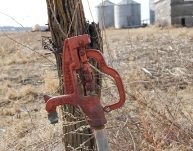Understanding Groundwater and Saturated Soil Conditions
Groundwater is stored in the voids, spaces and cracks between particles of soil, sand, gravel, rock or other materials. Saturated conditions occur when all of the voids, spaces, and cracks are filled with water. Unsaturated conditions occur when the voids, spaces, and cracks between soil, sand, gravel, or rock are filled with a combination of air and water.
Groundwater levels are higher than normal, and saturated soil conditions exist in areas close areas impacted by flooding. Saturated soil conditions present challenges and risks to homeowners.
Saturated Soil Poses a Risk to Private Well Water
 Normally, unsaturated soil acts as a filter to removing pathogens and many other pollutants from the water that will eventually supply wells. But when soil is saturated, it loses its ability to remove many pollutants.
Normally, unsaturated soil acts as a filter to removing pathogens and many other pollutants from the water that will eventually supply wells. But when soil is saturated, it loses its ability to remove many pollutants.
Under flood conditions, contaminated surface water may enter directly into groundwater through a nearby well that is not properly constructed, an old illegal well (often referred to as an abandoned well,) or other nearby excavation bypassing the natural filtering process. In addition, septic systems operating in saturated soils add pollutants to groundwater.
Research indicates that pathogens in saturated soil can remain viable and can move hundreds of feet, contaminating nearby drinking water wells
Homeowners who believe their well may have been impacted can voluntarily have the water tested for bacteria.
Saturated Soil Can Result In Septic System Failure
High groundwater and saturated soil conditions can be a hazardous situation for homeowners with septic systems. When saturated soil conditions persist, a septic system cannot function properly.
A septic system relies on a septic tank and drainfield to treat wastewater (sewage) and return it to the environment. Wastewater flows from the house to the septic tank where preliminary treatment occurs. Effluent flows from the tank to a drainfield and down through filter material, usually gravel. The effluent enters the soil where final treatment and recycling occurs.
One failure mode that can be hazardous, as well as quite unpleasant, is when the saturated soils cause wastewater to backup into the house or business. The soils are so wet and saturated that the wastewater is not able to drain away, and if a backup occurs the wastewater will usually flow out of the lowest plumbing fixture in the house, increasing the possibility of direct contact with the pathogens that cause illness. In addition, the cleanup is not a pleasant task.
An important factor in effluent treatment is the distance wastewater travels through the soil before reaching saturated conditions. Pathogens are destroyed or inactivated in the 3-to-4 feet of unsaturated soil below the bottom of the drainfield. If there is less than 4 feet of unsaturated soil; bacteria, viruses, and other contaminants can move into groundwater before being destroyed or inactivated. If the soil below the bottom of the drainfield is saturated, pathogens can remain viable and enter groundwater, which supplies drinking water wells in the area.
If your septic system is in saturated soils, you will need to avoid using water until the soil dries out sufficiently to allow drainage of the wastewater.
Saturated soil risk information by: current Nebraska Extension Associate, Becky Schuerman, Domestic Water/Wastewater Management and former Extension Educator, Sharon Skipton.